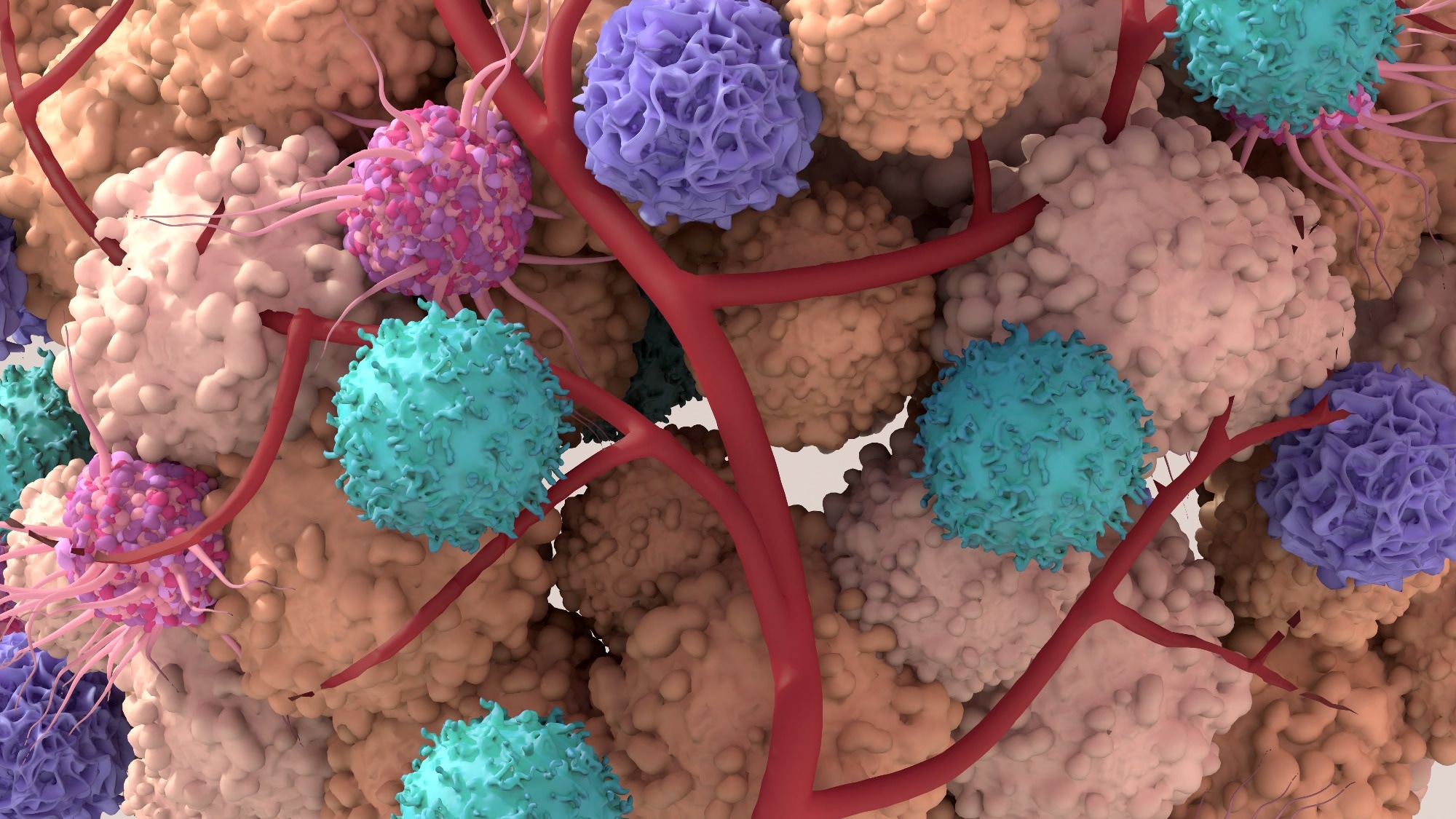In a recent study published in Science Translational Medicine, researchers identify shared immunogenic neoantigens in various cancers using the Splicing Neo Antigen Finder (SNAF) workflow, which integrates deep learning and new algorithms for advancing targeted cancer immunotherapy.
 Study: Splicing neoantigen discovery with SNAF reveals shared targets for cancer immunotherapy. Image Credit: Design_Cells / Shutterstock.com
Study: Splicing neoantigen discovery with SNAF reveals shared targets for cancer immunotherapy. Image Credit: Design_Cells / Shutterstock.com
Background
The primary aim in cancer treatment is to develop standardized therapies effective for most patients despite the inherent heterogeneity of cancer that often leads to drug resistance and relapse. Recent progress, especially in high-mutation cancers like melanoma, shows promising outcomes with neoantigen-based therapies; however, cancers with low mutation burdens pose challenges for traditional treatments.
Splicing neoantigens, which emerge from posttranscriptional changes, offers new possibilities in cancer targeting. Nevertheless, further research is needed to fully understand and effectively harness the potential of splicing neoantigens for broader and more precise applications in cancer immunotherapy.
About the study
In the present study, researchers develop a systematic pipeline to identify splicing neoantigens in heterogeneous cancers, focusing on melanoma and ovarian cancer. These cancers were selected for their comprehensive molecular omics datasets, including immunopeptidome and ribonucleic acid sequencing (RNA-Seq) data, diverse therapy regimens, and clinical outcomes.
Bulk long-read RNA-Seq in melanoma cell lines was utilized to capture a broad range of full-length messenger RNA (mRNA) isoforms. The sample size for the bulk RNA-Seq, immunoproteomics, and single-cell RNA sequencing (scRNA-Seq) datasets depended on the original study design.
For in vitro functional validation, neoantigen-major histocompatibility complex
(MHC) binding was confirmed using the transporter associated with antigen processing (TAP)-deficient T2 cell line. The immunogenicity and T-cell reactivity of neoantigens were evaluated using peripheral blood from at least three healthy donors.
SNAF, a modular Python package, was developed to automate splicing neoantigen identification and support both T- and B-cell neoantigen discovery. SNAF includes survival, mass spectrometry (MS) proteomics, and long-read analysis features.
SNAF was used to reanalyze bulk and single-cell RNA-Seq (scRNA-Seq) datasets, focusing on melanoma neoantigens and comparing them to noncancerous skin cells. Thirty-six synthesized neoantigens underwent validation, including MHC-I binding and immunogenicity tests, whereas confocal microscopy confirmed the localization of ExNeoEpitopes. Long-read mRNA isoform sequencing was conducted on melanoma cell lines and aligned with The Cancer Genome Atlas (TCGA) and Van Allen cohort data.
Statistical analyses in the study used a two-sided empirical Bayes moderated t-test for genomic comparative analyses, with false discovery rate adjustments for large datasets. Associations for individual neo-junctions or neoantigens with patient survival were derived using univariate Cox regression analysis.
Study findings
Two computational workflows were developed to identify and prioritize neoantigens for T- and B-cell-based therapies. SNAF identifies tumor-specific splice junctions and predicts immunogenic neoantigens (SNAF-T) and transmembrane proteins with potential as cancer-specific epitopes (SNAF-B). This approach, using deep learning and probabilistic algorithms, quantifies tumor specificity and immunogenicity of these neoantigens.
The study validated the prediction capabilities of SNAF-T using cancer immunopeptidome datasets, which revealed a higher detection rate of predicted neoantigens as compared to other methods. Seven of the tested neoantigens were validated through mass spectrometry, which indicated the potential of these neoantigens as targets for cancer immunotherapy.
Analysis of splicing neoantigen burden in melanoma patients showed that a high burden correlates with poor overall survival. In contrast, melanoma patients with a high neoantigen burden who received immune checkpoint blockade (ICB) therapy had improved survival, thus suggesting the significance of these neoantigens in predicting treatment response. Differential gene expression analysis revealed that a high neoantigen burden is associated with genes implicated in immune evasion, thus indicating that these patients may benefit from combination therapies.
Shared splicing neoantigens were found in over 15% of patients, thereby indicating their potential as common targets across multiple patients. These shared neoantigens were more frequently detected in independent cohorts and displayed a compositional bias in amino acids, suggesting a broader recognition by various human leukocyte antigen (HLA) genotypes.
The ability of selected shared splicing neoantigens to bind MHC and induce T-cell responses was observed. Furthermore, analysis of scRNA-Seq data showed that these neoantigens are primarily derived from tumor cells rather than the tumor microenvironment.
SNAF-B also successfully predicted full-length mRNAs and stable proteoforms of transmembrane proteins, which could serve as additional targets for therapies like chimeric antigen receptor T-cell therapy (CAR-T) cells or monoclonal antibodies. The study concluded with the development of interactive web applications for exploring and prioritizing predicted neoantigens to ultimately enhance the utility of SNAF in identifying targets for cancer immunotherapy.
Journal reference:
- Li, G., Mahajan, S., Ma, S., et al. (2024). Splicing neoantigen discovery with SNAF reveals shared targets for cancer immunotherapy. Science Translational Medicine. doi:10.1126/scitranslmed.ade2886